The air purifier removes unpleasant odors that appear during cooking, eliminates gas combustion products and purifies the air. The range of cleaners is diverse, all devices differ in their functionality, principle of operation, method of installation.
The difference between an air purifier and an exhaust hood and the principle of operation
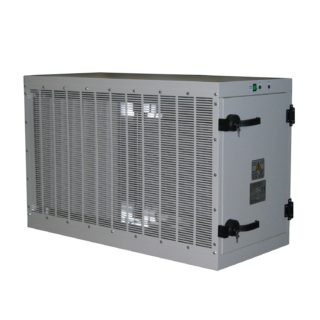
To clean air masses from grease, soot, odors, several types of devices are used, including hoods and air cleaners. Their differences lie in the principle of operation and design features.
The air cleaner draws in the dirty air, passes it through the filter group and returns it back to the room. Most hoods, on the contrary, bring it out or into the ventilation. Only a recirculating kitchen air purifier cleans the incoming air and returns it.
The design differs in the degree of mobility of each product. The cooker hood is a stationary appliance that is placed above the hob. To remove contamination, additional installation of the pipe is required, which complicates the installation. The kitchen filter above the stove instead of the hood, in turn, is more mobile, so it can be installed in any room in a suitable place. But the maintenance of such a device is more expensive than that of a cooker hood.
Also, devices differ in their performance (hoods purify a larger volume of air), cost, noise level, options.
Types of air purifiers
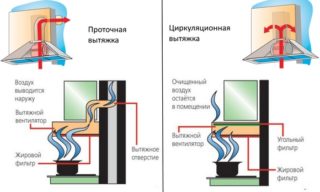
The classification of air purifiers for the kitchen above the stove is carried out according to different parameters. This is the principle of operation, installation method, functionality.
Classification by principle of action
Three groups of devices can be distinguished:
- Exhaust and flow. These are devices that, when turned on, suck in the air flow due to the operation of the fan. Together with the air, grease, soot, dust, small debris, odors and gas combustion products are removed to the outside. For the operation of such devices, it is imperative to organize the supply of fresh air to replace the remote contaminated air masses.
- Recirculating. The principle of operation is based on drawing in dirty air. It passes through the cleaning filters and is discharged back into the kitchen. Inside there is a coarse filter that removes large dirt, and a deep filter to remove the smallest particles. The filters need to be replaced periodically with new ones. Often, devices have an ionization and humidification function.
- Mixed type. Products operate in the mode of re-circulation of air masses or take them outside. These are universal models of air purifiers suitable for any premises. Their price is higher than that of flow and recirculation devices.
The most optimal are products of a mixed type. They can be used in any kitchen with any stove.
Installation classification

By the method of installation, there are:
- Suspended. Placed above the stove by hanging from furniture. These are the most common models due to their versatility, low price and ease of installation.
- Embedded. Hoods that are installed in furniture and fittings usually have a mixed principle of operation. They are invisible to the eye, so they will fit into any interior.They often have pull-out panels that are needed for more efficient cleaning.
- Fireplaces. Installed over a gas stove. Discharge air outside or into the ventilation system. It is used in large rooms, restaurants and cafes with professional kitchen equipment due to its high power. The most common types are dome-like appliances, but there may be other shapes.
- Mobile. These are devices that can be freely moved around the kitchen. Can be mounted on a table, floor, wall. Recirculating only.
The choice largely depends on the size of the room and its interior.
Filter classification
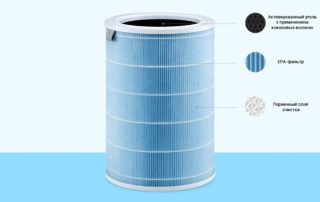
Recirculation models have several cleaning filters.
- Mechanical. These are coarse filters, which are a mesh with cells. Dirt, soot, lint and other debris settle on the grate. Requires regular cleaning.
- Photocatalytic. They break down organic compounds to harmless substances. They have a long service life and do not have a negative impact on human health.
- Coal. Activated carbon absorbs dirt and unpleasant odors. It is used only in combination with other filters.
- Electrostatic. They remove the smallest particles, which ensures the best cleaning of air masses. The dust enters the chamber, acquires a positive charge in it, after which it is attracted and deposited on the negatively charged plates. Does not require replacement. Rinse with water regularly.
- HEPA filters. They consist of fiberglass and allow high-quality air purification. Capable of capturing the smallest particles. Have a high price, periodically require replacement.
To maximize the degree of purification, several filters are used at once. Usually, the air first passes through a grate, which stops large debris, and then unpleasant odors and small particles are removed.
Additional options
Functional differences affect the cost of the device. The model can be equipped with an atmosphere control sensor, thanks to which the air cleaner turns on automatically as needed. A timer can also be set, with which you can set the operating mode. The filter indicator informs the owner about contamination and the need for a prompt replacement. More expensive models have a remote control.
Selection recommendations
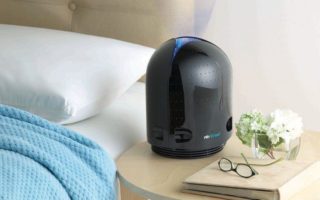
To choose the right kitchen air purifier, you need to pay attention to the following factors:
- The volume of the room. The device must have a commensurate work area with the kitchen.
- Air pollution level. The greater the degree of contamination, the more powerful the model is required and the more often the filters will need to be changed.
- Functionality. The average throughput of the device should be 150-700 cubic meters / hour.
The noise factor should also be considered when choosing a technique. The quieter it runs, the higher the quality.
Air cleaner installation
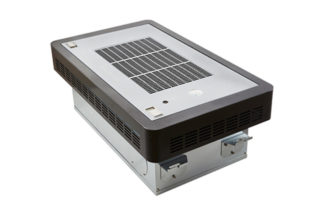
Installation algorithm:
- Selecting and preparing a site for installation. All household appliances should be installed prior to assembling and installing furniture.
- Connecting the socket to the installation site. It is best not to use an extension cord as it is unsafe in the kitchen. The socket should be positioned flush with the device and, if possible, hidden in a cabinet.
- Installation of the product. Depends on the model. Built-in is installed in the cabinet after hanging it or in front of it, it all depends on convenience. Hanging fasteners are attached to furniture.
Flow models require a duct connection. The circulating ones do not depend on the ventilation system; they can be hung on any wall.








